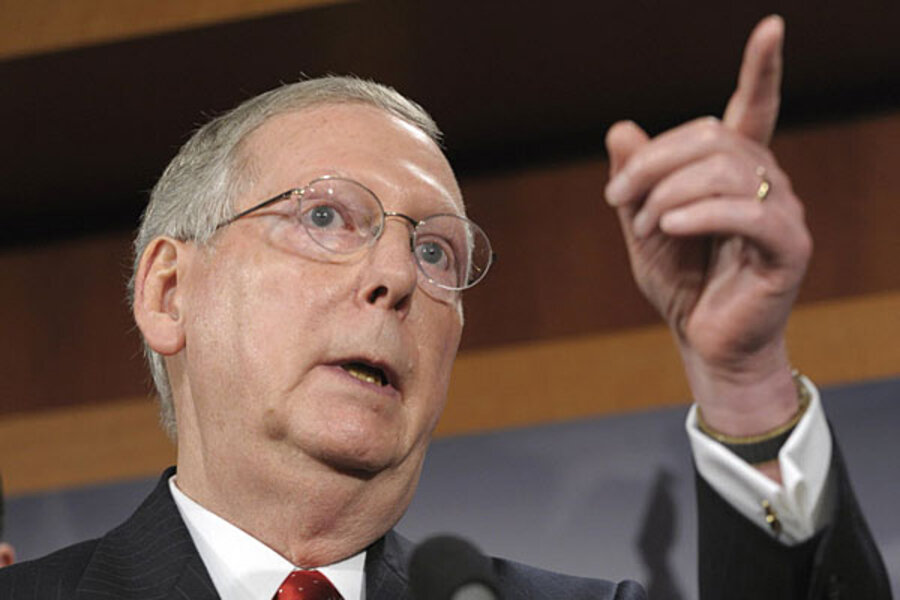McConnell's last ditch debt ceiling plan: What's in it for Republicans?
Loading...
| Washington
In a surprise move, Senate Republican leader Mitch McConnell on Tuesday proposed a “last choice option” to avoid default on the national debt that would require the support of just over a third of the House and Senate to raise the national debt ceiling.
The McConnell proposal, which requires special legislation to be adopted, gives the president expedited procedures to increase the debt limit by as much as $2.4 trillion that require only submission of a plan to reduce spending by a greater amount. There is no requirement that Congress actually pass those spending cuts.
But even if the cuts are never passed, the proposal has two political advantages for Republicans: It forces President Obama to lay out his proposed spending cuts in writing, a longtime GOP demand. And it absolves Republicans of responsibility for sending the nation into its first-ever default, as early as Aug. 2.
In exchange, Republicans give up all leverage on spending – riling many conservatives who elected a new GOP House majority to make tough decisions on spending, and diminishing Congress’s constitutional power of the purse.
Senate majority leader Harry Reid (D) Nevada said at a press conference that he did not know much about the plan, but stated: "I am not about to trash his proposal. It's something that I will look at."
“It’s an admission by Mitch McConnell that the votes won’t be there on the GOP side to do anything. They’re looking for a way out,” says Stan Collender, a longtime congressional budget analyst and partner at Qorvis Communications in Washington. “It puts the onus for raising the debt limit directly on President Obama.”
With both sides in deeply entrenched positions – Republicans refusing tax increases and Democrats refusing deep spending or entitlement cuts without them – default on the national debt is an outcome that some congressional leaders are taking more seriously.
Sen. Pat Toomey (R) of Pennsylvania proposed legislation requiring the Obama administration to come up with contingency plans to prioritize payments to avoid default after Aug. 2. Treasury Secretary Timothy Geithner has proposed invoking an obscure clause in the 14th Amendment to the Constitution as a basis for giving the president unilateral authority to raise the debt limit. [Editor's note: The original version of this paragraph did not list the correct part of government documents to which the president could refer.]
McConnell’s proposed legislative mechanism gives the House and Senate the option to defeat the proposed increase in the debt ceiling with a joint resolution disapproving of the president’s request that has little chance of success.
Either the resolution fails in either chamber – most likely in the Democrat-controlled Senate – in which case the debt limit increase goes forward. Or, the president vetoes the disapproving resolution, requiring a two-thirds supermajority to override the veto. In other words, it would take only 33 senators and 146 House members to sustain the presidential veto and increase the debt limit.
So, why is the Senate minority leader making it easy for President Obama to get a $2.4 trillion increase in the national debt limit? [Editor's note: The original version of this paragraph did not list the correct post for McConnell.]
McConnell says the aim is to take the unthinkable prospect of national default in the next three weeks off the table.
“We have become increasingly pessimistic that we will be able to reach an agreement with the only person in America who can sign something into law, and that’s the president of the United States,” he told reporters at a press briefing on Tuesday.
“What we are not going to be a party to in the Senate, I’m pretty confident, is default,” he added.
Conservative critics say it’s a way for Republicans to avoid taking responsibility for two unthinkable votes – either raising taxes or forcing the nation into default.
“It’s a classic game of chicken, and the Republicans say we’re willing to resolve this in an orderly way and here’s the formulaic mechanism we want to set in place,” says Michael Franc, who heads the Heritage Foundation’s outreach to members of Congress.
“President Obama can propose a debt increase with smoke-and-mirrors spending cuts, and fiscal conservatives don’t get spending cuts anywhere,” says Chris Edward, director of the tax policy studies at the CATO Institute, a libertarian think tank.
“What the Republicans should have done months ago was have reasonable cuts, pass them through the House and say: ‘This is what we want, and we’re not budging,’ ” he adds.
But Americans for Tax Reform (ATR), an anti-tax group, held off criticism on the grounds that the plan at least forces the White House to publish something like a plan to cut spending.
“The president has been allowed to promote imaginary spending cuts to which he would accede in order to get Republicans to agree to tax hikes,” said ATR president Grover Norquist, in a statement. “Republicans didn't bite. But President Obama, up until today, didn't have to disclose what imaginary spending cuts he was so reasonably prepared to accept.”
The plan also requires the president to make three separate requests for the full $2.4 trillion increase in the debt limit that he has been requesting. That’s three big votes before the 2012 elections – votes Republicans expect will focus voter attention on big government and run to their advantage.
To enact McConnell’s proposal, Congress must first pass a law that authorizes the president to submit a request asking for $2.4 trillion increase in the debt limit in three stages, with an initial request for $700 billion.
“One of the ways to deal with the budget is to deal with the budget process instead,” Mr. Collender says. “This is a bit of a throwback. It was inevitable that they would try to come up with some procedural gimmick.”





